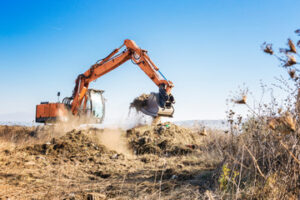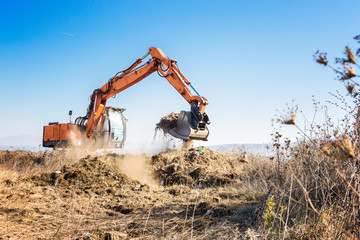Land clearing is a fundamental process in preparing a piece of land for various uses, such as agriculture, construction, and conservation. This practice involves the removal of trees, shrubs, rocks, and other obstacles to make the land suitable for its intended purpose. 
While it may seem straightforward, land clearing requires careful planning and execution to ensure safety, environmental sustainability, and compliance with regulations. Various factors influence the approach taken for land clearing, including the size of the land, the type of vegetation present, and the ultimate purpose of the cleared area. Contact Land Clearing Belton TX for professional help.
One of the primary reasons for land clearing is agricultural expansion. Farmers often clear land to create space for crops and livestock, ensuring they have adequate resources to support their agricultural activities. This process involves not only removing vegetation but also improving soil conditions to enhance productivity. Clearing land for farming often requires careful soil analysis to determine fertility and prevent erosion. Sustainable land clearing methods, such as controlled burning or mulching, help retain soil nutrients and reduce environmental impact.
Another major purpose of land clearing is for construction and urban development. Whether for residential, commercial, or industrial purposes, land must be cleared to provide a stable foundation for buildings, roads, and infrastructure. The process involves removing trees, leveling the ground, and sometimes altering natural water flow to prevent flooding. Proper land clearing techniques help ensure that the construction process runs smoothly and that the land remains stable over time. Contractors often work with environmental experts to minimize the impact on local ecosystems and comply with land-use regulations.
The environmental impact of land clearing is a significant concern, as it can disrupt ecosystems, reduce biodiversity, and contribute to soil erosion. When land is cleared irresponsibly, it can lead to deforestation, habitat destruction, and increased carbon emissions. To mitigate these effects, various methods are used to promote sustainable land clearing. Selective clearing, for example, allows specific vegetation to remain intact, preserving wildlife habitats and preventing unnecessary destruction. Reforestation and land rehabilitation efforts help restore areas that have been cleared, ensuring a balance between development and environmental conservation.
Different land clearing techniques are employed depending on the size and condition of the land. Manual clearing is often used for small-scale projects, involving hand tools such as axes, machetes, and chainsaws. This method allows for precise removal of vegetation but can be labor-intensive and time-consuming. Mechanical clearing, on the other hand, involves heavy machinery such as bulldozers, excavators, and mulchers. This approach is more efficient for large-scale projects, as it can quickly remove obstacles and prepare land for further use. However, it requires skilled operators and careful planning to avoid excessive environmental damage.
Another widely used land clearing method is controlled burning, which involves setting controlled fires to remove vegetation. This technique is particularly effective for clearing brush and enhancing soil fertility by releasing nutrients into the ground. However, it must be carefully managed to prevent wildfires and air pollution. In some cases, chemical clearing is used to eliminate unwanted vegetation through the application of herbicides. While this method can be effective, it requires careful handling to prevent soil and water contamination. Sustainable practices such as mulching and tree grinding help reduce waste by repurposing cleared vegetation into organic material that can benefit the soil.
Legal and regulatory considerations play a crucial role in land clearing. Authorities often impose restrictions and guidelines to protect natural resources and prevent environmental degradation. Landowners and developers must obtain permits and conduct environmental impact assessments before proceeding with land clearing activities. Non-compliance with regulations can result in legal penalties and long-term environmental consequences. Responsible land clearing practices ensure that land use remains sustainable and that natural habitats are preserved whenever possible.
The economic implications of land clearing are also significant. It contributes to the expansion of agricultural and urban areas, creating opportunities for investment and development. However, the costs associated with land clearing, including equipment, labor, and environmental restoration, must be carefully managed. Landowners and developers must weigh the benefits of clearing land against potential risks such as soil degradation and loss of biodiversity. Sustainable land management strategies help balance economic growth with environmental responsibility.
Technological advancements have played a crucial role in improving land clearing practices. Innovations in machinery, GPS mapping, and remote sensing have made the process more efficient and precise. Modern equipment allows for targeted clearing, minimizing unnecessary damage to surrounding areas. The use of drones and satellite imagery helps assess land conditions before and after clearing, ensuring that the process is carried out with minimal environmental disruption. These technologies also aid in monitoring reforestation efforts and tracking the long-term impact of land clearing on ecosystems.
Public awareness and community involvement are essential in promoting responsible land clearing. Local communities often have a vested interest in how land is managed, as it affects their environment, economy, and quality of life. Engaging stakeholders in decision-making processes helps create sustainable land-use plans that consider both development and conservation. Community-led reforestation projects and land rehabilitation initiatives contribute to restoring ecosystems and mitigating the effects of land clearing. Educational programs on sustainable land management encourage responsible practices and foster a greater understanding of environmental stewardship.
Despite the challenges associated with land clearing, there are ways to mitigate its negative effects and ensure that it is carried out responsibly. Implementing best practices such as erosion control, soil conservation, and habitat preservation helps maintain ecological balance. Landowners and developers must prioritize sustainable techniques that reduce environmental impact while achieving their objectives. By integrating modern technology, adhering to regulations, and fostering community engagement, land clearing can be conducted in a way that supports both economic growth and environmental sustainability.
In conclusion, land clearing is a complex process that requires careful planning and consideration of various factors. While it is essential for agriculture, construction, and development, it must be carried out responsibly to minimize environmental harm. Sustainable land clearing techniques, legal compliance, technological advancements, and community involvement all play a vital role in ensuring that land use remains balanced and beneficial for future generations. By adopting responsible land management practices, society can achieve progress while preserving natural resources and ecosystems for the long term.

